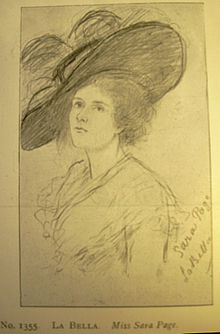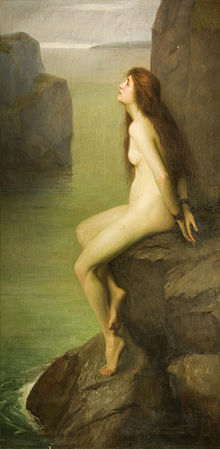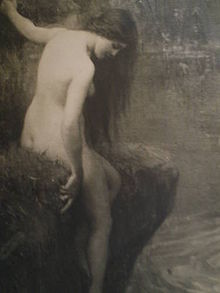- Sara Page
-
Sara Wells Page (1855–1943) was a British female artist, portrait and figurative painter, of Victorian and Edwardian period. During her lifetime she widely exhibited at Parisian salons and British galleries, including Royal Academy of Art. Her artworks have been preserved at Wolverhampton Art Gallery.
Contents
In England
Sara Page was born in 1855 at Moxley, Staffordshire into the prosperous family Wells-Page. Her maternal grandfather Thomas Wells (1804–1876) was a wealthy local Ironmaster.[1] His eldest daughter Sara Wells married Samuel Page, a successful timber merchant, and Sara Page was the fourth of their nine children. Both parents died in the 1870s,[2] leaving to their children a considerable fortune, which helped them to live independently, pursuing their own interests.
Between 1884-1891, Sara Page studied at Wolverhampton School of Practical Art,[3] and then went to Italy: ‘… the opportunity of visiting Italy came, and there I learnt to admire the works of the great masters of Renaissance, almost living in the galleries of Florence and Rome, sometimes trying to penetrate their thoughts by copying.’[4]
In 1892, after coming back from Italy, she exhibited at the Royal Birmingham Society of Artists a painting ‘Golden Venetian’. It was obviously influenced by her Italian impressions and its title suggests a visit to Venice. Sir Frederick Leighton encouraged her to continue studying art: ‘One day, Sir Frederick Leighton passing by, asked if I really desired to attain and when I said yes he advised me to go to school. This I followed, coming to Paris.’[4]
Paris
Sara Page arrived to Paris in c.1892, and entered the Académie Julian which already had an international reputation as an outstanding and highly successful art school. The catalogue of the 1893 exhibition of the Société des Artistes Français (SAF), names Sara as a pupil of Adolphe-William Bouguereau (1825–1905), Thoma Robert-Fleury (1837–1912) and Gabriel Ferrier (1847–1914) [5]: ‘I worked under the best French artists at the Académie Julian and found there both guidance and much interest in the companionship of many different nations, and as all the students (about 500) competed in efforts for the medal in painting and sculpture, life was animated.’[4]
Sara Page received a medal for portrait painting.[6] Among her artworks exhibited in 1892-1896 from Paris at the Royal Academy, London and at the Société des Artistes Français were portraits of members of her extended family who probably visited her in Paris. In the following years she continued to paint female portraits – ‘Beatrice’ (1899), ‘Theodora’ (1903), ‘Blondina’ (1914), ‘Isobel’ (1915, 1916), ‘Henriette’ (1935). Among other subjects - ‘A Capri Maiden’ exhibited in Birmingham in 1894, and ‘The Breton Peasant’ shown in 1893-1894 at the Royal Birmingham Society of Artists.
In 1897 she settled down at Neuilly-sur-Seine, a wealthy residential suburb of Paris with a strong artistic atmosphere. She maintained there her own studio and also took additional lessons from the well-established artists and leading exponents of the academic style Pascal Dagnan-Bouveret (1852–1929) and Gustave-Claude-Etienne Courtois (1853–1923). Both lived in Neuilly-sur-Seine, and had their studio at 73, Boulevard Bineau: ‘I … found a studio for working alone, the generous masters continuing to allow me visit theirs, and follow their pictures through their different stages. I learnt in this way the importance of putting character, masses and values before what so frequently tempts the inexperienced, to try and make a picture attractive at the expense of the greater side of Art.’[4]
Her greatest success was the exhibiting the large-scale oil painting ‘Andromeda’ at the Société Nationale des Beaux-Arts (SNBA) in 1902. It clearly demonstrates a familiarity with drawing from a live model and attempts to reach technical perfection. Both ‘Le rocher qui pleure’ (The Weeping Rock) exhibited in 1910, and ‘Le Baigneuse’ (The Bather) exhibited in 1911 and 1935 are very similar to ‘Andromeda’ in style, composition, and technique. As such, they can be seen as good examples of the French academic style of Bouguereau, Dagnan-Bouveret, and Courtois.
From c.1909, Sara Page studied with the miniature painter Gabrielle Debillemont-Chardon (1860–1957), the President of the Société des Femmes Peintres et Sculpteurs and of the Société des Miniaturistes et des Arts Precieux.[7] In 1910, she participated in the exhibition of miniatures at the George Petit Gallery, showing the picture of Dutch children.[8] Her miniature works exhibited in 1921 at the Gallerie Brunner, were favourably reviewed in the journal "Revue moderne des arts and de la vie".[9]
Living permanently in France, Sara remained in touch with her native country and her family. She exhibited at the Royal Academy, Walker Art Gallery, and Royal Birmingham Society of Artists. In 1926 she donated to Wolverhampton Art Gallery her 1902 painting ‘Andromeda’: 'The special interest I feel in giving ‘Andromeda’ /…/ to the Art Gallery, comes from the recognition it brings of the help I received in the School of Art, when first I studied drawing. This was long ago and not under the happy circumstances in which students work today in the spacious studios with their present gifted professor to guide and encourage them.’[10]
Last Years
Sara Page returned to England in about 1934. Her last years were spent with her sister Elizabeth Page in Parkstone, Dorset, where she died in 1943. In the same year, Sara’s sister Miss Elizabeth Page donated to Wolverhampton Art Gallery a small portrait ‘The Princess’, marking Sara’s death. Finally, the painting ‘Whisper of Spring’ was given by members of the Page family in 1977. A few of her works can also be accessed at the Poole Museum.
Artistic legacy
The available material presents Sara Page as a diligent artist experimenting with and trying differents artistic techniques, a follower of established academic tradition and an exponent of academic style in England. She did not manage to develop a strong and prominent professional career, but her life can be seen as a part of the strong late 19th-early 20th centuries international women movement and their struggling for education, self-expression, and independent careers. As such, it provides some additional information about the activity and outcome of the Académie Julian and forms a meaningful feature of artistic life in England and France on the turn of the 19th –20th centuries.[11]
Exhibited Artworks
- ‘A Golden Venetian’, 1892
- ‘Une Reve’, 1892
- ‘Elsie’, 1892
- ‘Miss Ellen Wells’, 1893
- ‘Portrait de Mlle E.P.’ 1893
- ‘Mada’, pastel, 1893
- ‘Une paysanne bretonne,’ pastel, 1893
- ‘A Capri Maiden’, watercolour, 1894
- ‘Study of Fruit’, oil, 1894
- ‘A Breton Peasant’, oil, 1894
- ‘Une reponse attendue’, 1894
- ‘Innocence’, 1895
- ‘Harmony in Blue’, 1896
- ‘Portrait de Mlle K…’, pastel, 1896
- ‘Juin’, pastel, 1896
- ‘La Marquise’, pastel, 1897
- ‘Beatrice’, pastel, 1897
- ‘Violettes’, 1900
- ‘The Princess’, painting on ivory, 1901.© Wolverhampton Art Gallery
- ‘Andromeda’, oil, 1902. ©Wolverhampton Art Gallery
- Frame containing 2 miniatures
- ‘La Bella’,drawing, 1902
- ‘Theodora’, 1903
- ‘The Lace Maker’, 1903
- ‘Reflection’, 1906
- ‘La Marquise’, drawing, 1906
- ‘Spring’, 1906
- ‘The Whisper of Spring’, oil, c.1910. © Wolverhampton Art Gallery
- ‘Le Rocher qui pleure’ (The Weeping Rock),oil, 1910
- ‘Le marquis’, drawing, 1910
- “The Dutch Children”, c.1909
- ‘La Baugneuse’ (The Bather), oil, 1911
- ‘La faunesse’, drawing, 1911
- ‘La liseuse’ (Reading Woman), 1912
- 'L'écharpe rose’ (The Rose Scarf), drawing, 1912
- ‘Jeune fille de France’, miniature, 1912
- ‘The Rose Scarf’, 1913
- ‘Louise’, miniature, 1914
- ‘Blondina’, 1914
- ‘Isobel’, 1915
- ‘A la fontaine’, 1920
- 'L'Emir', 1921
- 'Le Bonnet blanc', 1921
- 'Charlotte', 1921
- ‘La chale jaune’, miniature, 1925
- ‘Solitude’, miniature, 1925
- ‘Storm Clouds’, 1934
References
- ^ Census 1861
- ^ Memorial at All Saints Church, Moxley
- ^ Wolverhampton Local Studies. DX-831/4/1.
- ^ a b c d WAG. Letter from Sara Page. 13 February 1926.
- ^ Palais des Champs Elysees. Explication des ouvrages de peinture, sculpture, architecture, graveure and lithographue des artistes vivants. Paris, 1893. P.123.
- ^ WAG. Letter from Sara Page 13 February 1926.
- ^ Catalogue illustré de peinture et sculpture.Société des artistes français. Salon 1925.
- ^ New-York Tribune, 23 January 1910, p.4.
- ^ Sara Page. In: "Revue moderne des arts and de la vie". 1921, 28 February.
- ^ WAG. Letter from Sara Page.13 February 1926.
- ^ Gabriel P.Weisberg, Jane R.Becker (ed.). Overcoming All Obstacles: The Women of the Académie Julian. The Dahesh Museum of Art, NY.1999.
Further reading
- Crespon-Halother, Beatrice. Les peintres britanniques dans les salons parisiens des origins à 1939. 2002.
- Graves, Algernon, The Royal Academy of Arts: a Complete Dictionary of Contributors and their Work from its Foundation in 1769 to 1904.
- The Dictionary of British Artists. 1880-1940.
- Morris S. and Morris K. A Catalogue of Birmingham & West Midlands Painters of the Nineteenth Century. 1974.
- The Society of Women Artists Exhibitors. 1855-1996. Vol.3, 1996.
- Catalogues of Spring and Autumn exhibitions of the RBSA (Royal Birmingham Society of Artists. 1880-1943.
Categories:- 1855 births
- 1943 deaths
- English artists
- Portrait artists
- British women artists
- People from Wolverhampton
Wikimedia Foundation. 2010.



